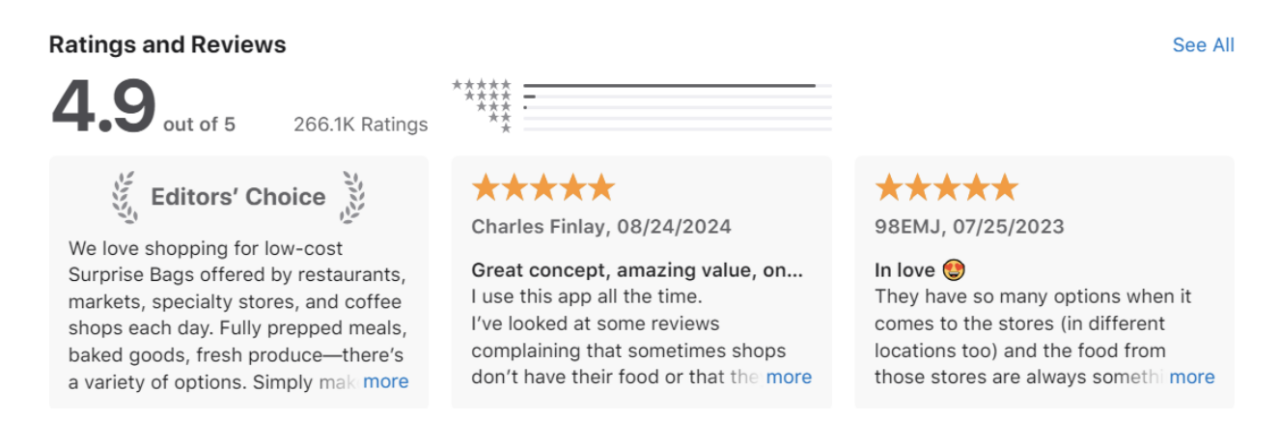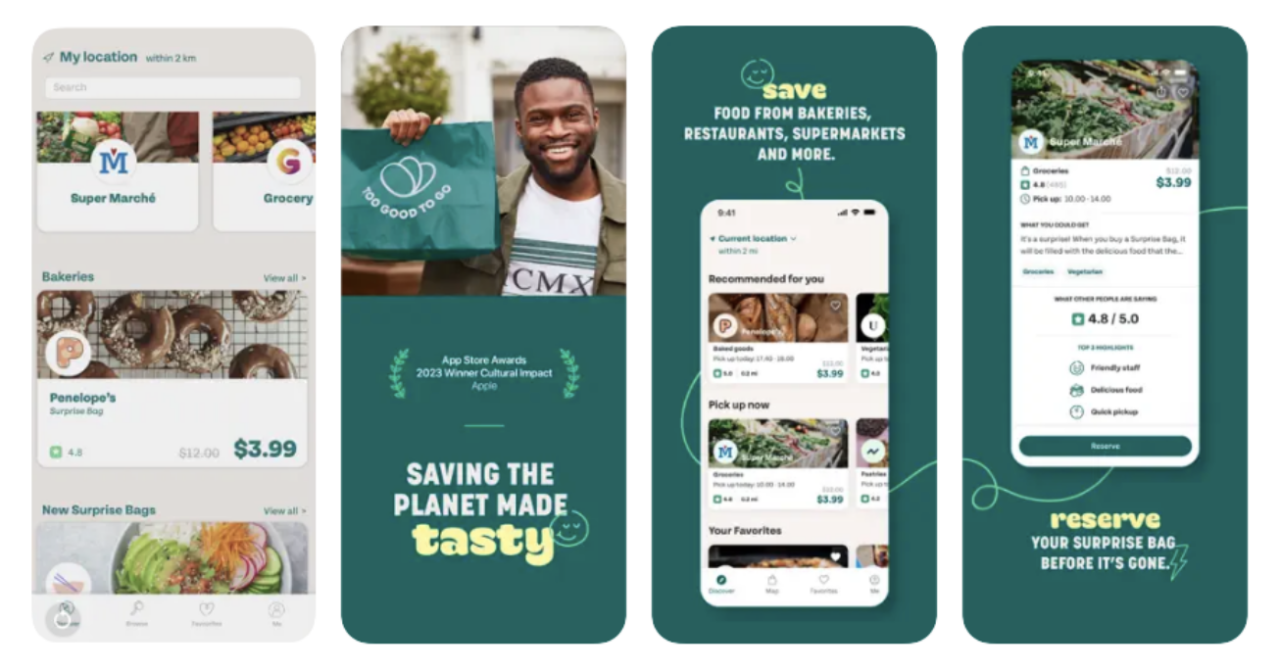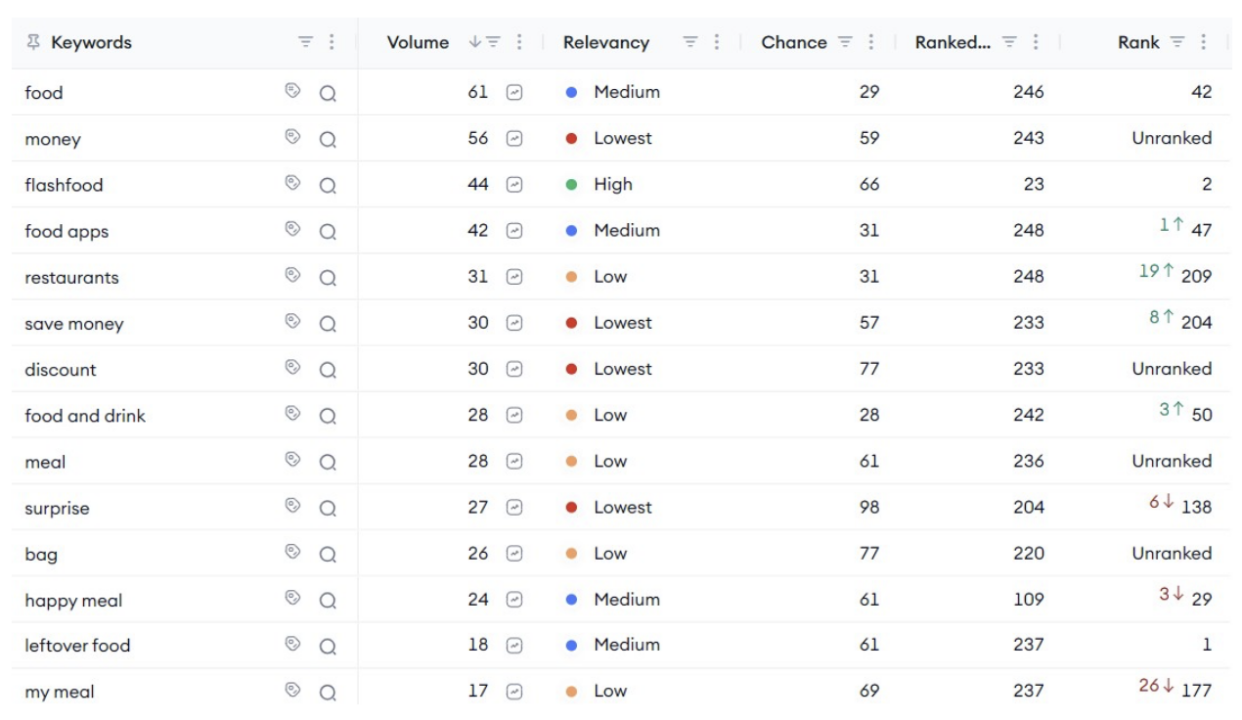
Too Good To Go ASO Audit Report
Too Good To Go iOS App
Too Good To Go is among the world’s largest surplus food marketplaces in app stores today. With over a million people downloading the app, It has enjoyed a relatively high ranking in the App Store. In fact, by the time of this writing, it is rated to be the #16 app in the food and drink category based in the United States.
While Too Good To Go has already accomplished things that the world’s largest surplus food marketplace hasn’t achieved, there is still a way to maximize their app store visibility and increase their chance of getting noticed.
After all, the biggest room for improvement is the room for improvement. No matter how great Too Good To Go might already be, it can still do something to reach the number one spot and avoid being overtaken by competitors.
In this ASO audit, let’s take a look at how Too Good To Go can improve its keyword ranking in the most efficient way possible.
Too Good To Go Keyword research
We did a quick keyword research for Too Good To Go based in the United States. We have shared the details at the end of this post.
Looking at the research result, we can see that we are already ranking for some important keywords. Nevertheless, we have identified some great opportunities for us to take advantage of.
In this situation, ASO intelligence tools come in handy. These tools are effective in identifying popular keywords with the lowest competition. For example, in ShyftUp, we use Mobile Action to perform reliable keyword research.
Among the results we get is the term Search Score. Here’s a quick overview:
The Search Score ranges from 5 to 100. The score represents the number of users who are searching for a specific keyword compared to other keyword options in the App Store and Google Play.
For example, one of the keywords with the highest ranking is the keyword “Facebook.” It has a search score of 100.
The lowest score is 5, which means no one is virtually searching for that keyword. Most keywords will never even see a score beyond 5.
Going back to the results that we got, here’s what Too Good To Go’s ranking looks like:
- “Food” keyword has a search score of 60, which we rank at no. 42.
- “Restaurants” keyword has a search score of 44, which we rank at no. 237.
- “Food apps” keyword has a search score of 42, which we rank at no. 45.
- “Leftover food” keyword has a search score of 18, which we rank at no. 1.
- “Save money” keyword has a search score of 30, which we rank at no. 212.
- “Food and drink” keyword has a search score of 28, which we rank at no. 58.
We also did research on competitor keywords. We got the following results:
- “Karma” keyword has a search score of 47, which we rank at no. 69.
- “Flashfood” keyword has a search score of 44, which we rank at no. 2.
- “Olio” keyword has a search score of 30, which we rank at no. 2.
The results show us that there is a lot of work to do. To ensure that we climb up the rankings, we should use these keywords in our metadata.
Title
The title of Too Good To Go in the App Store is this:
Too Good To Go: End Food Waste
Too Good To Go already has an optimized title. The app is utilizing the full 30-character limit allowed by the App Store, ensuring maximum keyword potential.
The current title includes high-performing keywords such as “end” (Search Score: 39), “food” (Search Score: 61), and “waste” (Search Score: 21). Given the strong search scores of these keywords, the title is already effective and well-optimized.
We will keep the title as it is. While it’s important to continuously analyze keyword rankings and performance, the current title aligns well with the app’s goals and search trends, making it unnecessary to test alternative titles at this stage.
Subtitle
The subtitle of Too Good To Go in the App Store is this:
Save tasty & eco-friendly food
Like the title, Apple allows up to 30 characters for the subtitle, and currently, Too Good To Go is utilizing the full 30 characters.
Analyzing the keywords included in the subtitle, the search scores are as follows: “save” (53), “tasty” (32), “eco-friendly” (5), and “food” (61). While most of the keywords have high search scores, “eco-friendly” has a lower score. Additionally, the keyword “food” is used in both the title and subtitle, which creates redundancy.
If we decide to test a new variation, the subtitle could be updated to:
Save Money & Meal Discounts
As you can see, we have added the words “money” “meal” & “discounts” and excluded the words “tasty”, “food” & “eco-friendly.” This is a great move in terms of keyword ranking for the following reasons:
- The term “meal” has a high search score of 28.
- The term “discounts” has a high search score of 20.
- The term “money” has a high search score of 56.
- By adding the term “money” we can potentially rank for longer search terms such as “save money” & “saving money”. Both have good ranking scores, which are 30 & 26, respectively.
To ensure we stay competitive, we must test the subtitle and its keywords continuously. One way to improve the subtitle is to go to the keyword pool. From there, we should continuously check how many keywords that are in the subtitle. For instance, we should check the keyword “money” in our keyword pool.
After starting to use the “money” keyword, do we start ranking higher for these keywords? Do we start ranking for more keywords that include “money”? If the keywords are not improving our ranking, then we should test other keywords and their variations.
Ratings
Looking at the ratings, we can see a lot of things to improve here. Take note that Too Good To Go, at the time of this writing, has an average rating of 4.9 stars from more than 266.1K users.
Let’s compare that to their competitors:
We do need to improve app features and overall user experience to raise the ratings up and get more positive reviews.
Screenshots
Screenshots can either make or break your app. If you use the wrong screenshots, you’ll surely chase away users. Use the right screenshots, and you’ll attract more users.
As we take a look at Too Good To Go’s screenshots, we can see that they have chosen great images. However, Too Good To Go can use more value-oriented headlines on the screenshots. It is super important to choose screenshots that show the value, features, and reasons why users should use your app. Here are some of our feedback for Too Good To Go:
- Readability: Some subheadings have small font sizes, making them difficult to read. Increase font size for subheadings to improve clarity, especially on smaller screens.
- Headline Strength: Headlines are clear but lack a strong call-to-action (CTA). Use more action-oriented headlines like “Start Saving Food Today” to drive engagement.
- Social Proof: While impact statistics (e.g., CO2 avoided, money saved) are shown, user testimonials or ratings are missing. Include user reviews or trust badges (e.g., “5 million meals saved”) to enhance credibility.
- Cover Screen & Image: The cover screen uses engaging visuals but lacks emphasis on key app benefits. Highlight a core benefit like “Save Money and Reduce Food Waste” prominently on the first screen.
- Visual Hierarchy: Some screens feel cluttered, with overlapping text and visuals. Simplify the layout by prioritizing key elements and maintaining consistent spacing.
- Feature Highlights: Not all unique features (e.g., surprise bag pickup process) are fully explained. Add short descriptions or icons to visually highlight each feature’s value.
- Consistency: Font styles and sizes vary across different screens, creating inconsistency. Standardize fonts and maintain a uniform style throughout the screenshots.
The App Store allows us to use up to 10 screenshots. However, these screenshots don’t have equal exposure. As you may already know, potential users will initially see the first three screenshots. They need to open your page to see the rest of the screenshots.
With this in mind, you need to choose the best screenshots and place them on the first three screenshot slots.
To determine which screenshots give you the best result, A/B testing and Apple’s Product Page Optimization (PPO) are always the best way to go.
Here are a few more things to consider:
- Apple indexes the title, subtitle, and keyword list to determine app rankings in the App Store.
- The app title, which can be composed of up to 30 characters, is considered to be the most important ranking factor. Thus, you should add the most crucial keyword to your title. When you do that, you’ll most likely get a higher ranking for that keyword.
- Next to the app title is the subtitle in terms of importance for indexing. Thus, other more vital keywords should be added to your subtitle. Add as many relevant and high-ranking keywords as possible to ensure you increase your ranking. Moreover, if possible, maximize the 30 character-limit for the subtitle.
- The keyword list is considered to be the number 3 most important ranking factor in the App Store. You are allowed to use a maximum of 100 characters. You need to add all the keywords that you believe are relevant to your app. You can even include brand names and competitors’ keywords. You have more flexibility to include whatever you see fit based on your keyword research. After all, users won’t be able to see this list. Only you, as the admin, can see them via the App Store Connect. But it affects your visibility significantly.
This data is pulled from Mobile Action.
Disclaimer: In this ASO Audit, we haven’t used any private data, we have purely used public data.


